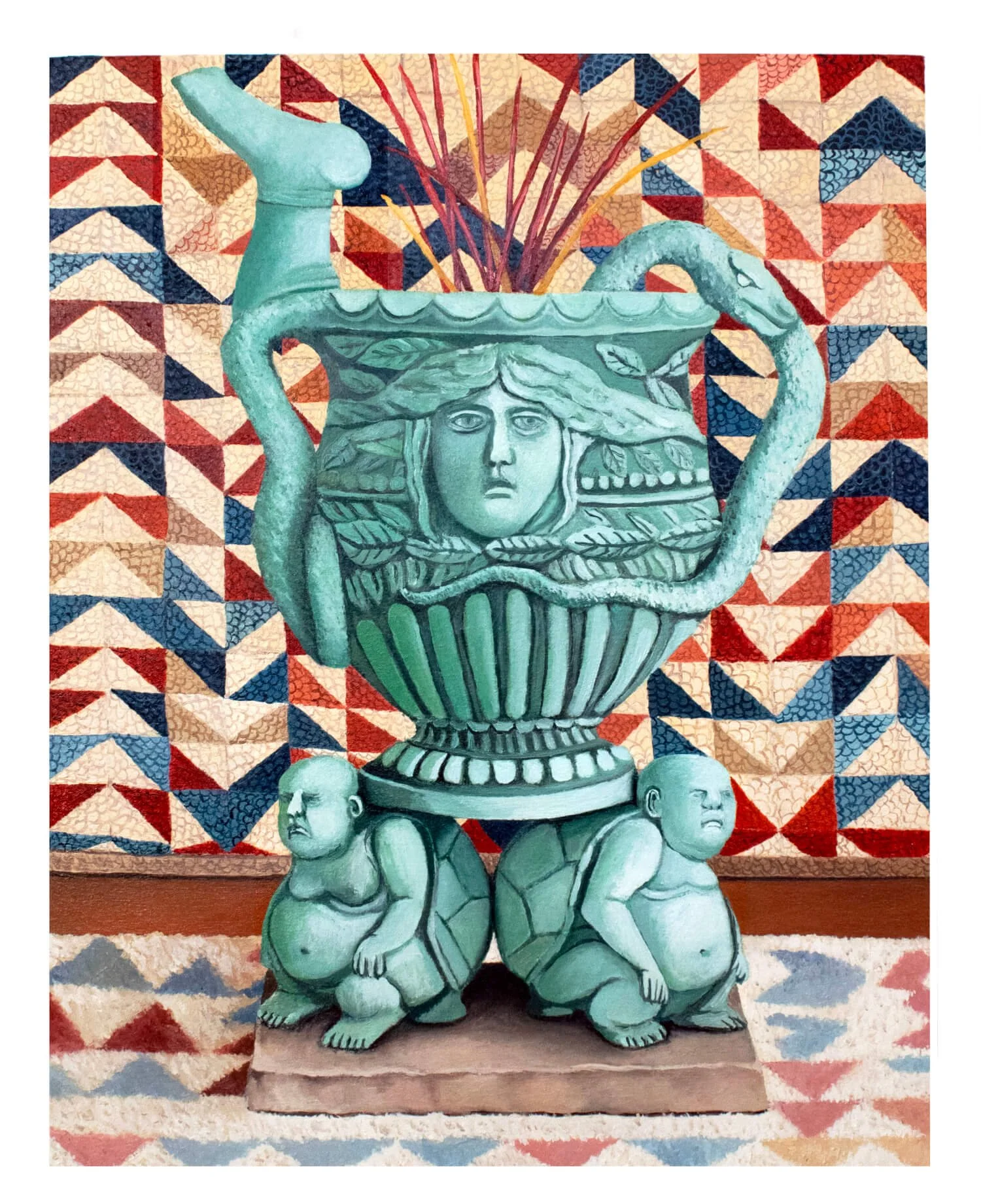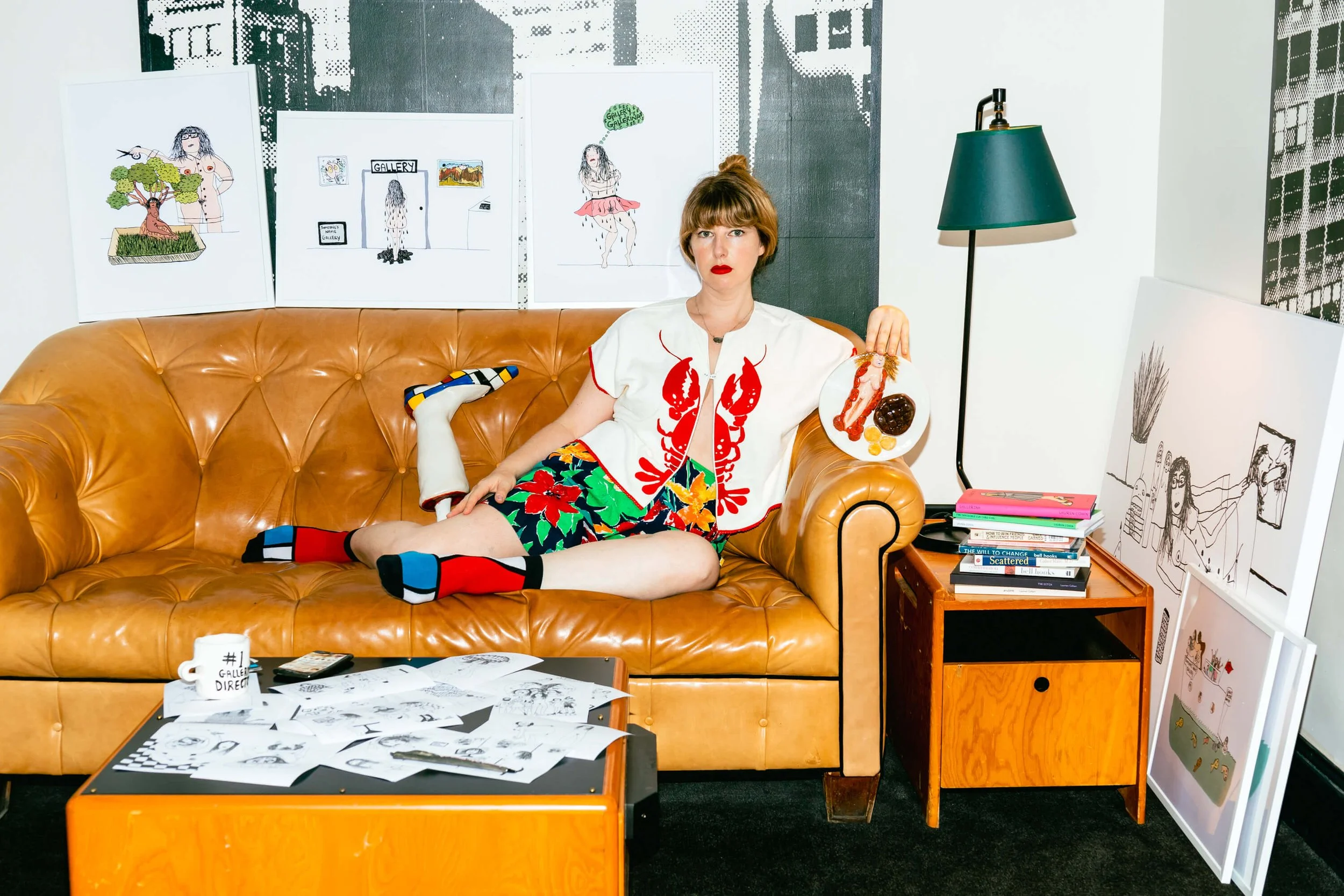Lauren Cohen: Constructing Surreal Americana Through Painting and Ceramics
Lauren Cohen lives and works in Brooklyn, NY. She holds a BFA from California College of the Arts, San Francisco, CA, and a Master’s from the Royal College of Art, London, UK. Her work has been exhibited at Marinaro Gallery, The Hole, Ace Hotel, Future Fair presented by LoftProjects, KinoSaito, Raynham Hall Museum, Ghost Machine Gallery, Felix Art Fair presented by Voloshyn Gallery, Westbeth Gallery, Wassaic Project, Spring/Break Art Show, The Museum of Modern Art Department of Film, Van Der Plas Gallery, Trestle Gallery, The Maine Jewish Museum, Patricia Sweetow Gallery, The di Rosa Center for Contemporary Art, The London Institute of Contemporary Art, The Blyth Gallery, and Goldsmiths College of London.
She has been an Artist in Residence at MacDowell, NARS, Skowhegan School of Painting & Sculpture, The Josef and Anni Albers Foundation, and MASS MoCA. Previous juried exhibitions include Bloomberg New Contemporaries, The Catlin Guide, and Saatchi New Sensations. Forthcoming exhibitions include Powerhouse Arts, Brooklyn, and Second Street Gallery, Charlottesville, VA.
follow the artist on Instagram: @laurencohenstudio
Interview
What is the story behind your latest body of work, and what first sparked the idea for it?
My interdisciplinary practice—spanning painting, ceramics, and installation—investigates systems of control, power, and the construction of identity. My work centers on the figure of the other within society, drawing connections between historical archetypes and my own lived experiences to construct fictional mythologies that blur the line between past and present.
My newest paintings and ceramics unfold like stage sets for an alternate American history. The spark came from a return to the domestic objects and maritime stories of my New England childhood—quilts, figureheads, and nautical folklore—seen now through the lens of a divided present. I began photographing and sketching my family’s house in Danvers and imagining Civil War–era interiors where quilts were both practical and symbolic. These images evolved into dream rooms populated by soldiers, ship models, and hybrid ceramic forms, all rendered in a palette of reds, blues, and dusty pinks that nod to patriotism while questioning it.
By splicing antique quilt patterns with fragments of my own life, I create rooms and figures that are both familiar and uncanny: a Union soldier draped in a quilt, a faceless figure guarding a ship. The pieces speak to containment and the longing to escape, echoing the emotional landscapes of isolation and communication that shaped my youth. This body of work continues my commitment to building a surreal Americana, where private memory and public history meet in objects that invite the viewer to question what is inherited and what can be remade.
Are there personal rituals or habits in your studio that help you get into a creative flow?
I have a morning routine of chatting with my father while we do remote fitness together. I go to my local park and power walk while we cover topics that range from current events, politics, the weather, and our daily musings. After that, I stop at a coffee shop to draw and write about my work. My practice is research-based, so there isn’t a moment when I’m not processing ideas to weave into my paintings and ceramics. I like to go through Instagram to see what other artists are posting or looking at. I check out curators and galleries who are sharing their projects and usually post a story of my coffee with a little good morning message.
Along my walk, I’m checking out flowers, holiday decorations on people’s stoops, and there are a couple of local neighborhood artists who paint faces and forms on discarded objects. I snap images of these small interventions and continue on my way. This quiet sequence of movement, observation, and connection has been my start for the last several years and feels deeply ritualistic. From there, I settle into either my ceramic studio at Powerhouse Arts or my painting studio across the road in the Can Factory.
What images, memories, or experiences keep resurfacing in your work, even when you do not expect them to?
I think a lot about the interior spaces of historic homes in my hometown and the surrounding areas. There are remnants of old wallpaper or textiles that may or may not have been there originally, and I love this idea of a constructed environment. I often find myself needing to figure out what is truth and what is fiction. Imagery from the Salem witch trials also enters my work because that is what I was immersed in and surrounded by growing up. My town is Danvers, which is old Salem Village, so these layered histories and ghostly traces naturally resurface in the worlds I build.
How do you balance play and experimentation with discipline and structure in your practice?
All the different parts of my practice—from daily drawings that become cohesive graphic novels, to studies of imaginary quilts and textiles, to satirical paint-by-numbers responding to current politics, and snapshots of evolving characters—begin in the privacy of the studio and often remain unseen for a time. I share only when a body of work has passed through an internal process of experimentation, reflection, and critique. The studio itself is a living, breathing space where play and discipline overlap, and where growth and transformation occur. It feels rare and special when a visitor truly experiences the full breadth of this layered practice.
Can you share a breakthrough moment when you saw your work or yourself as an artist differently?
I have a tendency to want to illustrate certain ideas in my work. The challenge has been taking the next step, creating artwork that communicates what I’m trying to say in a less direct and more layered way. Working with fabricators at Powerhouse Arts has been key to this shift. Explaining my intentions and watching them translate those ideas into form has pushed the work forward and helped me see both the process and my role as an artist differently.
What conversations do you hope your work starts for those who encounter it?
My work opens conversations about power, belonging, and resilience. It grows from personal experiences of feeling undervalued and outside the center, then looks outward to how those feelings echo through many lives. By turning these histories into paintings and ceramics, I aim to create moments of recognition and hope, where individual and collective stories meet.
What upcoming project feels the most exciting or risky for you right now?
I am finishing a new body of work centered on an imaginary future home where my future self can live. It draws from the architecture and contents of my childhood house while opening onto the current political terrain and a speculative vision of where things might go. This project extends my long-standing practice of world-building and character development, which began as a way to cope with chaos when I was young. What once felt like unconscious disassociation has become an intentional creative strategy. I can now enter that invented world fully present and shape its narratives with purpose. This fertile, evolving terrain feels both thrilling and risky, offering new beginnings and unexpected outcomes.










